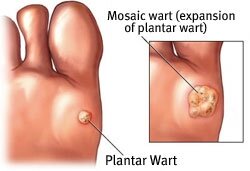Warts
Description
A wart, or verruca, is a small bump on the skin caused by a virus that infects the top layer of skin cells. Warts are believed to be transmitted through direct or indirect contact (via a gym or shower floor) with a person carrying the virus. This virus, called human papilloma virus (HPV), is easier to “catch” if there is a cut or an abrasion on the skin. |
|
Plantar warts are non-cancerous skin growths that occur on the bottom of the feet. They frequently are studded with pinpoint dark spots, which are tiny, clotted blood vessels. When they occur on portions of the feet that bear weight, they are flattened by the weight placed on them, and can be quite painful. They can be confused with corns; however, corns lack surface pinpoint dark spots. Another diagnostic evaluation can be done manually; plantar warts or veruca are very painful upon lateral compression and less so on direct digital pressure. A deep seeded corn, keratosis, callous will be more painful on direct pressure.
Symptoms and Causes
Symptoms: Rough or “warty” bumps that are skin-colored, white, tan, or pink; typically pea-sized or smaller; pain in warts that occur on weight-bearing portions of the feet. Often irregular and “cauliflower like” in appearance. The lesions appearing on the dorsal or top of the foot are more typical in appearance as described. The lesions located on the bottom of the foot or toes may be difficult to distinguish from seeded corns or other types of weight bearing callous tissue.
Causes: You acquire warts through direct contact with the human papillomavirus (HPV). There are more than 100 types of HPV. Some types of HPV tend to cause warts on your hands, fingers or near your fingernails. Others tend to cause warts on your feet.
The virus that causes plantar warts isn’t highly contagious, but it thrives in warm, moist environments, such as shower floors, locker rooms and public swimming areas. So you may contract the virus by walking barefoot in public places.
Like other infectious diseases, HPV may also pass from person to person. If you have a plantar wart, you can even spread the virus to other places on your own foot by touching or scratching. The virus can also spread by contact with skin shed from a wart or blood from a wart.
Each person’s immune system responds to warts differently, so not everyone who comes in contact with HPV develops warts. Even people in the same family react to the virus differently. That’s why parents and kids don’t necessarily spread warts by sharing the same shower.
Treatments and Prevention
Plantar warts may occasionally go away on their own, but most people require treatment for them. Since there is some evidence they will disappear spontaneously it has been suggested in some literature that there is a psychogenic overlay in the care and treatment of verruca.
Unless you have an impaired immune system, diabetes, poor circulation (vascular disease), or you are pregnant, there’s no reason you can’t treat warts with over-the-counter remedies. But you may wish to consult your doctor for help.
Unfortunately, no wart treatment works 100 percent of the time. If treatment does not seem to be working after a time, or the warts appear worse, we recommend that you discuss the problem with your foot and ankle specialist.
Prevention: Reducing your risk of plantar warts:
-
Avoid direct contact with warts. This includes your own warts.
-
Keep your feet clean and dry. Change your shoes and socks daily.
-
Don’t go barefoot in public areas. Wear shoes or sandals in public pools and locker rooms.
-
Don’t pick at warts. Picking may spread the virus
